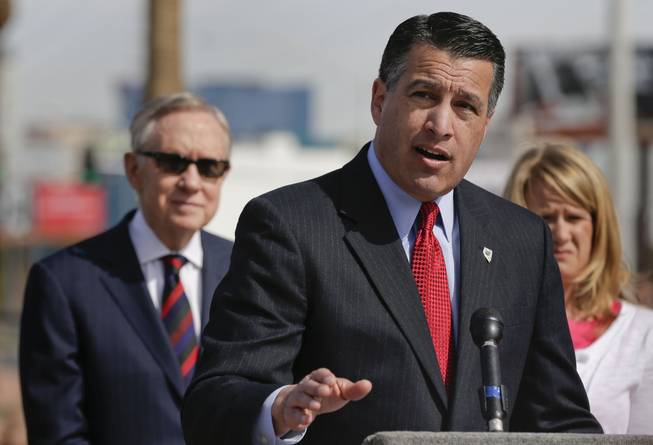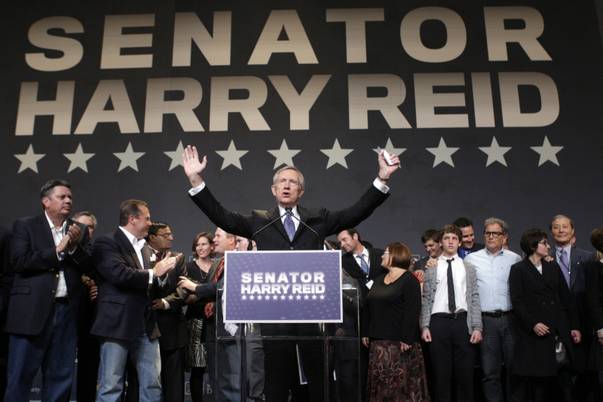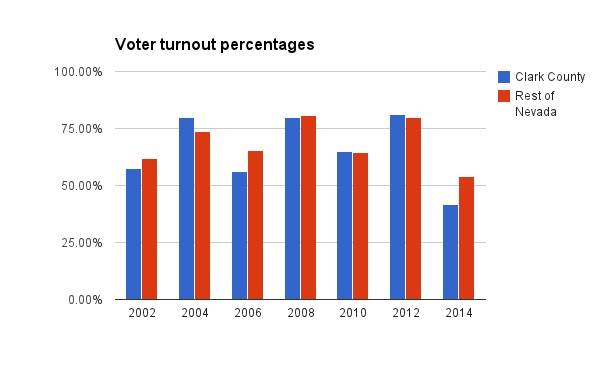
Julie Jacobson / AP
Nevada Gov. Brian Sandoval speaks during a news conference Thursday, March 20, 2014, in Las Vegas. Sandoval and Senate Majority Leader Harry Reid, left, talked about a new report that shows at least $5.5 billion has been invested in Nevada’s clean energy sector since 2010.
Thursday, Nov. 6, 2014 | 2 a.m.
In a state where Sen. Harry Reid's political machine has called the shots and where voters backed President Barack Obama twice, how did the tide turn so decisively for Republicans and Gov. Brian Sandoval in 2014?
Here are six reasons.
The mood in Nevada and the nation powered Republicans to the polls
There was a single theme that unified voters across America on Tuesday — exasperation; exasperation with President Barack Obama and a gridlocked Washington.
In the absence of issues to campaign on, Republicans seized on the anti-Obama sentiment. They knocked on doors and made calls with vigor, encouraging voters to cast their vote Tuesday against Democrats and Team Obama.
It worked better than expected in Nevada and nationally.
Editor's note
This story was reported by Sun political reporters Ana Ley, Amber Phillips, Kyle Roerink, Conor Shine.
Republicans crushed Democrats up and down the Nevada ballot and across the country. The checkerboard of American politics turned into a blanket of red in the U.S. Senate and House, governor's mansions and state Legislatures. Not since 1929 have the Republicans controlled the governor's seat, the Senate and the Assembly.
Obama's approval rating nationally has been hovering in the low 40 percent. That's down from a peak of the high 60s after he was sworn into office in 2009. Obama's approval numbers are higher than George W. Bush at the same point in his second term but far lower than Bill Clinton's.
Nevada, as it has for years, proved to be a bellwether for the nation. Since 1908, the state has voted for every successful presidential candidate except one.
This time, urban Democrats weren't compelled to show up at the polls, and rural Republicans were. The Republican victories in Nevada, said longtime Nevada Republican strategist Jim Denton, "come down to two words: President Obama."
The Reid machine sputtered
With the Tea Party surging in 2010, Sen. Harry Reid ran a nearly flawless campaign to win re-election in the fight of his life. It was the crowning achievement of Reid's Nevada Democratic machine. He and his strategists further perfected their get-out-the-vote efforts in the 2012 presidential election when Obama carried the state with 52 percent of the vote.
This year, Reid and his ace political team had much more to juggle. U.S. Senate Democrats were defending seven seats in red states. Reid's team raised millions for the Senate Majority political action committee, trying to almost single-handedly keep the Senate. Reid himself criss-crossed the nation courting donors. Nevada Democrats also lacked a compelling statewide race to rally the party.
Both factors gave Reid little reason to abandon the national campaign trail to spend his time and money in Nevada.
But Reid's close ally Billy Vassiliadis defended the senator, saying he was able to multi-task. It was just a bad year for Democrats. "I think there’s a myth that he’s so focused on the U.S. Senate races that he’s not paying attention to Nevada," Vassiliadis told KNPR before the election. "And that’s just not true. He is focused on Nevada and he’s focused on Kansas and Georgia."
The Karl Rove factor
It could be argued that Karl Rove helped push Republican congressional candidate Cresent Hardy to an unexpected victory over incumbent Democratic Rep. Steven Horsford.
The Republican adviser's Super PAC made a late-October play in the 4th Congressional District with a $1 million ad buy against Horsford.
In fact, Rove's Crossroads GPS and other Republican outside groups played a major role in races across the nation, according to the Center for Public Integrity.
Here in Nevada, both sides say they're not clear if Rove's ads stuck. Sure, it sparked national attention, visits from Joe Biden and Bill Clinton and another half a million dollars in spending from both sides. But what really won the day for Hardy was voter turnout from Republicans motivated enough to go to the polls.
Republicans beat Democrats at their game
To defeat Democrats, the GOP stole a page from the Democrats' playbook.
Nevada Republicans watched in horror in 2012 as the state re-elected Obama. Democrats kept control of the state Assembly.
Like the national party, Nevada Republicans recognized they needed to change to compete with Obama, Reid and the Democrats. That meant a new focus on technology, grassroots organizing through groups like Engage Nevada and improved coordination among conservative groups.
In Clark County, the party's Southern Nevada arm had been ineffective for years. It didn’t coordinate with candidates. It didn’t raise big money. It didn’t work with the media.
In the summer of 2013, the county GOP ousted its old leaders and elected new ones. It elected more new officials in March and changed its platform to be more inclusive and began working toward Nov. 4.
One key change in strategy: coordinating with campaigns. Instead of having campaigns and parties working separately for the same cause, they joined forces and worked together with consultants working for Senate and Assembly candidates, said Nick Phillips, the Clark County GOP political director.
“The Republican ground game was engaged and energized and moving toward something: a message of change and one of support,” said Greg Ferraro, a lobbyist and Sandoval adviser.
In Nevada's 4th Congressional District, retail politics was all that mattered. Hardy's team knew he could win the race, despite being out-funded and out-staffed by Horsford's team, if they simply knocked on enough doors — 25,000 to be exact.
In the primary, Hardy's team received a significantly higher share of the vote in precincts his campaign staff physically walked than precincts they couldn't make it to.
Democrats laid down on the ground
While the GOP gained momentum, Democrats couldn't recapture the energy of Obama's change and hope campaigns in 2008 and 2012.
Democrats used those campaigns to build an advantage in voter registration of 62,000 over Republicans.
The party’s ground game — a touchstone for the party’s success in presidential years — was offbeat, its messaging was weak and Washington support was a liability, said Eric Herzik, a political science professor at the University of Nevada-Reno.
“Republicans were offering the hope of an alternative,” he said. “That was the big theme of last night. People voted against the status quo and the status quo nationally was Democratic.”
The Democrats didn't have a cause or candidate on the ballot to rally around. Democrats in marquee races couldn't mobilize voters. An education funding ballot question — a typically Democratic topic — had meager support from top Democrats. Business leaders, though, used the measure's tax increase on businesses to rally Republican voters. “There was no corresponding message on the other side,” Ferraro said.
The bottom line: Without Reid or Obama, Democrats couldn't motivate their base.
“That would worry me if I am the Democrats,” Herzik said.
Las Vegas didn't vote
If you're looking to unpack where things went wrong for Democrats, Clark County is a good place to start.
Only 41 percent of Clark County voters cast a ballot this year, compared to 54 percent in the rest of the state. (Overall, statewide turnout was the lowest since 1978.)
That matters to Democrats because three-quarters of all Nevada Democrats are registered here. The low Clark County turnout gave outsized influence to the reliable, rural voters that lean heavily Republican.
The effects of the low turnout were most acute in two races Democrats expected to win easily only a few months ago.
Congressman Steven Horsford won Clark County by a slim 1,900 vote margin, a steep drop from 2012 when he won the county by 29,000 votes. Although Horsford improved in the rurals this year, the low Clark County turnout left him exposed. Republican Cresent Hardy beat Horsford by 5,500 votes in the rurals and went on to win the race by 3,600 votes.
In 2010, Democrat Ross Miller won Clark County by 101,000 votes in his race for secretary of state.
In his attorney general race this year, Miller won Clark County by just 19,000 votes. That wasn't enough to protect him against rural losses where Republican Adam Laxalt beat him by 25,000 votes.



Join the Discussion:
Check this out for a full explanation of our conversion to the LiveFyre commenting system and instructions on how to sign up for an account.
Full comments policy